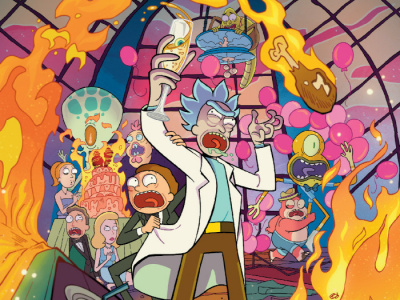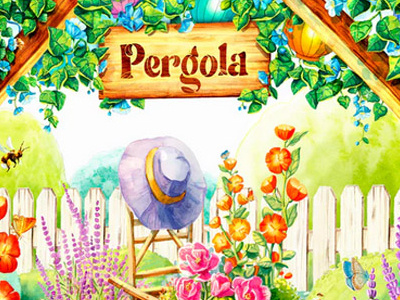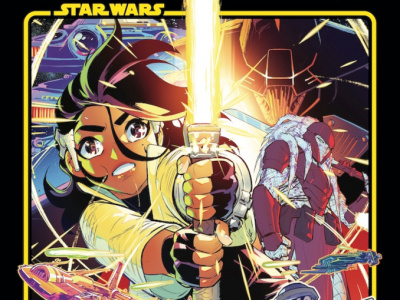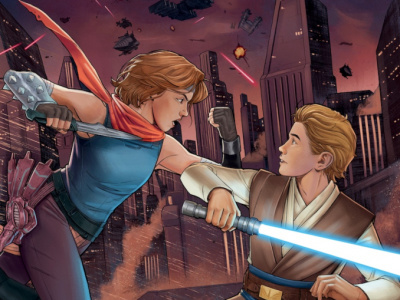
We talked with Senior Vice President Sales Bob Wayne and Vice President of Marketing John Cunningham about July’s comic sales, the current vogue for variants, and Wayne’s 25-year tenure at DC Comics. Wayne also announced that DC was making the four new comic titles launching in September returnable for retailers starting with the "zero issues."
First off, what are your impressions of the July numbers?
Wayne: We were number one in dollars and number one in units, so we were pretty pleased about that. We also did very well with the Batman: Earth One hardcover, which was number one on Diamond’s book list, while at the same time we’ve had a similar success with it in the book trade, which is something that you guys reported on (see "'Batman' Tops Bookstore Sales"). Plus our periodicals are doing well. If it hadn’t been for Robert Kirkman and Skybound putting out Walking Dead #100, I think we could have had an even nicer month. We said nice things before about their book format releases before, and we are going to say a nice thing about their comics this time--that was an astounding success with The Walking Dead #100 and we think that’s the kind of thing that keeps the market vibrant and it’s exciting for everybody whenever a book performs that way.
Cunningham: Plus while the weather was really hot, the humidity wasn’t too bad, so that helped make July even better.
DC won the marketshare in spite of the fact that you guys actually lost a point of share from June, Marvel just lost more. Was that due to The Walking Dead?
Wayne: Image had a really good month.
Bob, you just had your 25th anniversary with DC, can you give us your reflections on a quarter century of working in the comics industry?
Wayne: You are correct. Today is my anniversary day with DC. I have been on staff in the office for 25 years, and there have been enormous changes during those 25 years. Sometimes it feels like more than 25 years.
Have those changes been for the better?
Wayne: Some of them are for the better. I think that the industry is in a good healthy spot right now. We have evolved from having a dependence solely on periodicals with one-month shelf lives to having the book format being of almost equal size in dollars. We and many of our esteemed competitors keep books in print as long as there is a continuing demand for them, and at the same time we have expanded the ways in which people can enjoy our books by additional outlets in the book trade. We are also back in some places in the newsstands that we haven’t been in years, and we have our successes in digital that have happened concurrently with market growth over the past year and have been additive, they haven’t subtracted from the growth in print sales.
Cunningham: Plus comics today don’t come on those heavy stone tablets that they did when Bob first started in comics, so it’s a lot easier on his back too.
We noticed that there was only one Before Watchmen title in the Top Ten in July, are those books still performing as you had hoped?
Wayne: The Before Watchmen titles are selling about where we thought they would be. If it had been The Walking Dead #99 in July, we would have had two Before Watchmen titles in the Top Ten. All the Before Watchmen titles are in the Top 20 in July, except for one, which came in at #21.
What’s your impression of variant covers--do you think they are responsible for a greater percentage of sales this year than in 2011? Is there more reliance on variants as a marketing tool?
Wayne: I think that in our case it was one of the ways we used to incentivize people to try the "New 52" titles, and take a deeper position on them for retail. So we didn’t really have a lot of variants a year ago because we hadn’t started the "New 52" rollout yet. But this is a tool that I think kind of runs in cycles, so we are currently figuring out what we are going to have for variants over the next couple of months. We just got through deciding in the last day or so that we are going to add four variants for September. We are going to have them for Phantom Stranger, Sword and Sorcery, Talon, and Team 7, the books that are debuting as "Zero" issues, and we are going to add returnability for retailers on that as well. Instead of doing the variants and returnability with issue #1, we are going to begin with the "Zero issues" to encourage more people to stock up on those books. We will be announcing that later today or on Monday.
Considering the success you have had with the Night of the Owls crossover event within the batbooks family, are you considering doing more intra-family "events," and what about the potential for a universe-wide crossover?
Cunningham: "Well we’ve got another one of those intra-family crossovers coming up in the fall with the Green Lantern books. I think that in our case, these events are always driven by the stories that the creators think up, believe it or not. So between the Green Lantern event and the "rot-world" crossover with Animal Man and Swamp Thing certainly the table has been set for what is about to come. If those are successful, if the stories keep coming from other creators, you will see within the family and hopefully out of the family crossovers depending on what the editorial group comes up with.
But there’s no sort of universe-wide event on the horizon?
Cunningham: No comment.
July’s growth in comic sales was even over and above the blistering 18% average for 2012 so far, do you think that the comic market can keep up this blistering pace for five more months and make 2012 a real year to remember for growth in comic book sales?
Cunningham: I don’t think that we are seeing anything in the numbers that suggests that the tricks that we are doing as well as the tricks that other publishers are doing to pull people into the stores won’t continue to work. It’s a really terrific year for the direct market.
Wayne: And by "tricks" of course John means the outstanding editorial content and the brilliant sales and marketing initiatives, not "tricks" in the pejorative sense.
Bob noted that Geoff Johns’ Batman: Earth One was tops in both the bookstore and direct markets. We’ve noticed that the bookstore market, which in terms of graphic novel sales used to be more backlist-oriented than the direct market, is becoming more congruent in its sales patterns with the comic shops, do you agree?
Cunningham: Not at all. DC has always had a leadership role when it comes to opening up the bookstore market, and I think from our earliest experience we knew that the differences between the markets was not nearly as great as their similarities. So we are not surprised that the same books are bestsellers in both markets. We are glad that other publishers are able to understand this now and are finding ways to make their products work on both sides, because that’s been our operating principle for years and years.
It used to be that there was a lag between when a property like Sandman or The Walking Dead would get popular in the comic market and when it would start to sell the bookstores, but that gap appears to be shrinking, doesn’t it?
Wayne: That’s probably been the case for us for may be the last four years or so. We’ve really taken a very aggressive position. Certainly as long as I have been responsible for both channels of distribution, and when John Cunningham joined us from a prior life in the book trade, we’ve tried to work to take advantage of a growing synergy between customers making similar decisions in both channels. We found that they (book store and comic shop patrons) aren’t such different animals as people have thought in the past.
John Cunningham: To use your formulation, I think that the only "lag" that occurs is the timing of publication, what with the periodicals coming out first in the direct market. In every meeting that we have had with our sales representatives from Random House who distribute our books in the book trade, that we continually and have always based our expectations on how books are going to perform in the bookstores and mass market based on their performance as periodicals. We see clear correlations there and that has always been one of our driving points, and in fact it is one of the things that made us very confident of our success when we went out with the graphic novel collections of our "New 52" material, because we had already established that connection with the book trade, saying here’s what something was doing as a periodical and here’s what we think it will do as a collection. We were then able to demonstrate that the numbers for the "New 52" books were so dramatically above where we had been before that it made it very easy for our book trade representatives to understand that our expectations for the "New 52" graphic novels were much higher as a matter of course. And the good news is that the sales have turned out to mirror those projections and validate that philosophy entirely.
Do you think that the tremendous success of The Dark Knight Rises and the publicity leading up to its release have played a role in the popularity of Batman: Earth One and other Batman graphic novels?
Wayne: Historically every time one of Christopher Nolan’s Batman films has come out, there’s been enough material from our existing library of Batman titles that people have noticed and we have had a spike in sales of Batman books, and this time is no exception. We have been very blessed that Chris and his team have drawn so much direct inspiration from the comics that it really allows a lot of people to seek out and go further into the Batman backlist, which is very strong and which has benefited every time there has been a new Nolan Batman movie.







